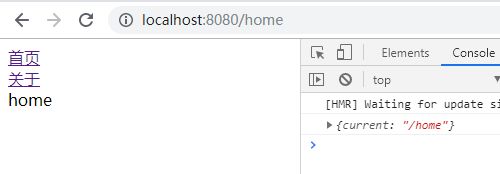遇到面试vue-router原理
前端三大框架Vue,React,Angular,他们都是单页面应用开发的,所以利用路由的跳转非常有必要的,vue-router,react-router,angular-router都是基于前端路由原理进行封装实现的,所以我们使用起来非常方便,只会使用还不行,刚上手的小白,给他随便说两句就会使用路由,但是我们也需要了解路由的原理,知己知彼,才能百战百胜。
一、什么是路由
路由的概念起源于服务端,在以前前后端不分离的时候,由后端来控制路由,当接收到客户端发来的 HTTP 请求,就会根据所请求的相应 URL,来找到相应的映射函数,然后执行该函数,并将函数的返回值发送给客户端。他也存在这优势与劣势:
- 优势:
安全性好,seo优化性能高 - 劣势:加大服务器的压力,不利于用户体验。
所以前端路由才有了发展的空间。
前端路由的来源:
在很久很久以前~ 用户的每次更新操作都需要重新刷新页面,非常的影响交互体验,后来,为了解决这个问题,
便有了Ajax(异步加载方案),Ajax给体验带来了极大的提升。
虽然Ajax解决了用户交互时体验的痛点,但是多页面之间的跳转一样会有不好的体验,所以便有了
spa(single-page application)使用的诞生。而spa应用便是基于前端路由实现的,所以便有了前端路由。
如今比较火的vue-router/react-router 也是基于前端路由的原理实现的~
二、路由模式
前端路由:主要有两种模式hash模式和history模式。
1.hash模式
URL的hash 是以#开头,是基于location.hash来实现的。Location.hash的值就是URL中#后面的内容。当hash改变时,页面不会因此刷新,浏览器也不会请求服务器。
同时,hash 改变时,并会出发相应的hashchange时间,所以,hash很适合被用来做前端路由。当hash路由发生跳转,便会触发hashchange回掉,回掉里面就可以实现页面的更新操作,从而达到跳转页面的效果。
// 当Html文档加载完毕后,会触发load事件
window.addEventListener("load",()=>{
// 在浏览器中有一个api叫location
console.log(location.hash)
// location是浏览器自带 也就是说是Hash路由的原理是location.hash
box.innerHTML = location.hash.slice(1) //slice把前一个字符串去掉
})
// hashchange 当hash改变时触发这个事件
window.addEventListener("hashchange",()=>{
box.innerHTML = location.hash.slice(1)
})
2.history模式
主要是HTML5的History API 为浏览器的全局history对象增加的扩展方法。
pushState:
需要三个参数:一个状态对象, 一个标题(目前被忽略), 和一个URL
- state, 状态对象state是一个JavaScript对象,popstate事件触发时,该对象会传入回调函数
- title, 目前所有浏览器忽略
- url, 新的url记录
replaceState:
history.replaceState()的使用与history.pushState()非常相似,区别在于replaceState()是修改了当前的历史记录项而不是新建一个。
onpopstate:
需要特别注意的是,调用history.pushState()或history.replaceState()不会触发popstate事件。只有在做出浏览器动作时,比如点击后退、前进按钮【或者调用JS中的history.back()、history.forward()、history.go()】才会触发该事件。
如果当前处于激活状态的历史记录条目是由history.pushState()方法创建,则popstate事件对象的state属性包含了这个历史记录条目的state对象的一个拷贝。
history.pushState({},null,pathname)
//使用popstate事件来监听url的变化
window.addEventListener("popstate",()=>{
console.log(location.pathname)
go(location.pathname)
})
三、vue中路由的实现格式
下面我们以vue中的router为例,看下vue如何实现路由的:
router.js:
import Router from 'vue-router'
Vue.use(Router)
export default new Router({
mode: 'history',
base: process.env.BASE_URL,
routes: [...]
})
main.js:
import router from './router'
new Vue({
router,
render: h => h(App)
}).$mount('#app')
四、承上启下
上面我们已经了解了hash和history的原理,下面我们就来手写一把vue-router的源码。
可以看出来vue-router是通过Vue.use的方法被注入Vue实例中,在使用的时候我们需要全局用到vue-router的router-view和router-link,以及this. r o u t e r / router/ router/route 这样的实例对象。那么这些背后如何操作呢?
五、vue-router源码分析
下面就开始亲手开撸一个简单的vue-router:
第一步: install方法
可以创建一个Vue项目,将router中的路由信息抽离出来,主要的源码在vue-router中。当Vue.use(vueRouter)时候,就会调用vue-router中的install方法
通过Vue.mixin()方法,全局注册一个混合,影响注册之后所有创建的每个 Vue 实例,该混合在beforeCreate钩子中通过Vue.util.defineReactive()定义了响应式的_route属性。所谓响应式属性,即当_route值改变时,会自动调用Vue实例的render()方法,更新视图。
Vue.mixin({ //mixin 混入
beforeCreate() {
// console.log(this.$options); //每一个vue组件
// console.log(this.$options);
//获取根组件 因为根组件下面 有router
if (this.$options && this.$options.router) {
// 找到根组件
// 把当前实例挂载到_root上
// console.log(this);
// 把router实例挂载到_router上面
this._router = this.$options.router
this._root = this // main 根组件
//监控路径的变化 为了让 _router 的变化能及时响应页面的更新,所以又接着又调用了 Vue.uti.defineReactive方法来进行get和set的响应式数据定义。
Vue.util.defineReactive(this, "xxx", this._router, history)
} else {
// console.log(this); //app组件
this._root = this.$parent._root;
}
Object.defineProperty(this, "$router", {
get() {
return this._root._router
},
push(){
}
})
Object.defineProperty(this, "$route", {
get() {
return {
current: this._root._router.history.current
}
}
})
}
}),
第二步: crateMap转换路由格式
将路由信息转换格式,利用createmap转换路由信息格式。
createMap(routes) {
return routes.reduce((memo, current) => {
//meomo刚开始是一个空对象
memo[current.path] = current.component;
return memo;
}, {})
}
第三步: 创建VueRouter类,初始化mode routes routesMap对象
在路由里面new了,说明 vue-router中是一个类,此时 ,将new中的对象options 传到VueRouter类中。将mode routes routesMap history挂载到VueRouter上,并使用了init方法。
class HistoryRoute {
constructor() {
this.current = null;
}
}
constructor(options) {
// console.log(options);
this.mode = options.mode || "hash";
this.routes = options.routes || [];
this.routesMap = this.createMap(this.routes);
this.history = new HistoryRoute();
this.init();
}
第四步: hash 和history
在constructor中使用this.init()方法,在init方法里面可以判断路由的mode是hash还是 history。
init() {
if (this.mode === "hash") {
location.hash ? "" : location.hash = "/"; //#/会加上了
// console.log(location.hash);
window.addEventListener("load", () => {
this.history.current = location.hash.slice(1)
// console.log("load-->", this.history.current)
})
window.addEventListener("hashchange", () => {
this.history.current = location.hash.slice(1)
// console.log("hashchange-->", this.history.current)
})
} else {
//使用history
// console.log("History");
location.pathname ? "" : location.pathname = "/";
window.addEventListener("load", () => {
this.history.current = location.pathname
// console.log("load--->", this.history.current)
})
window.addEventListener("popstate", () => {
this.history.current = location.pathname
// console.log("popstate--->", this.history.current)
})
}
}
// 把方法写到$router上去
push() { }
go() { }
back() { }
六、实现效果图:
七、原理总结:
通常构建一个Vue应用的时候, 我们会使用Vue.use以插件的形式安装VueRouter。同时会在Vue的实例上挂载router的实例。在vueRouter这个插件中有一个公共的方法install,这个方法的第一个参数是Vue构造器,第二个参数是一个可选的参数对象,其中在install文件中,并且混入了mixin,给每一个组件创建beforeCreate钩子,在Vue的实例上初始化了一些私有属性,其中_router指向了VueRouter的实例,_root指向了Vue的实例。
在Vue中利用数据劫持defineProperty在原型prototype上初始化了一些getter,分别是 r o u t e r 代 表 当 前 R o u t e r 的 实 例 、 router 代表当前Router的实例、 router代表当前Router的实例、route 代表当前Router的信息。在install中也全局注册了router-view,router-link,其中的Vue.util.defineReactive, 这是Vue里面观察者劫持数据的方法,劫持_route,当_route触发setter方法的时候,则会通知到依赖的组件。
接下来在init中,会挂载判断是路由的模式,是history或者是hash,点击行为按钮,调用hashchange或者popstate的同时更新_route,_route的更新会触发route-view的重新渲染。
参考:https://segmentfault.com/a/1190000017853553
https://juejin.im/post/5d469f1e5188254e1c49ae78#heading-12



